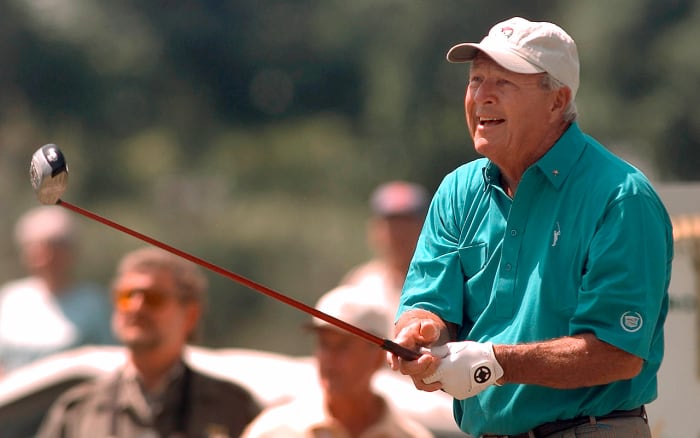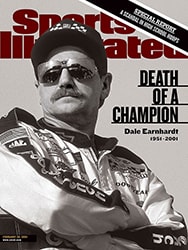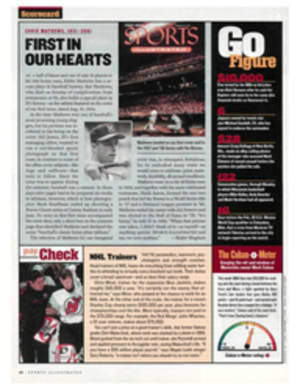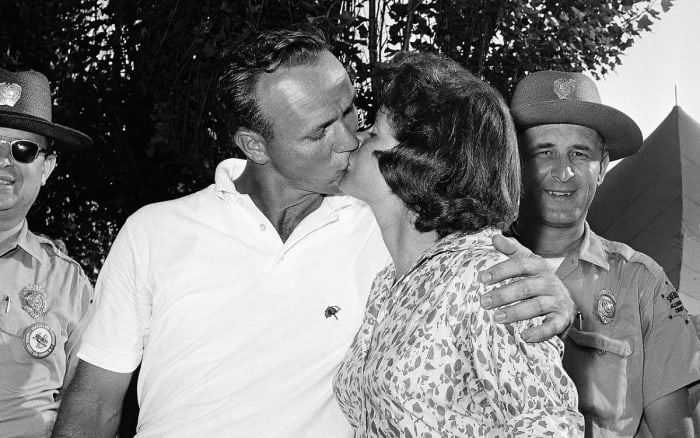No Time For Trouble
Despite everything, he still sleeps well. He has always slept well. He puts his massive head, his massive, granite, iconic head, on a pillow somewhere around half past nine, regardless of the time zone, and six or seven hours later he wakes up, before the first light, ready to tackle the day. His enthusiasm for the tackle—his enthusiasm for being Arnold Palmer—that's what has made him a legend, the King. He's a rich man, worth more than $200 million, but you could say he lives unpretentiously. He has a house in Latrobe, Pa., where he was born 71 years ago. He has a condominium at the Bay Hill Club, in Orlando. He has a casita at the Tradition, a new gated community in the California desert. His only true extravagance is his jet, a $15 million Citation X with cashmere throw blankets. A working pilot, he flies himself home from somewhere, pours himself a drink or two, eats a man-sized dinner, watches his Golf Channel (he's chairman of the board), makes a call or two, climbs into his pajamas and into his bed and sleeps like a man without a care in the world.
His waking hours are not so restful. It has been this way for a while, long before the Callaway nonconforming-driver thing came up, although that has been a major headache, the most tumultuous event for Palmer in his nearly half-century in the public eye. Palmer tries to shield his public from the clamor inside his head. The other day, while running errands near the Tradition, in La Quinta, he popped his head into a restaurant under construction. The place was all dangling wires and dusty sinks, with electricians and plumbers hanging from ladders and crouching behind pipes. These are the men who have always been Palmer's people. "Electric's a week behind schedule, plumbing two, painting's nowhere," Palmer said, making mischief. "When's anybody going to eat in this place?" He chortled in the Palmer manner, his chin disappearing into his bull neck. The working men, strangers to Palmer only technically, laughed with him. This was vintage Palmer, connecting. When he's in public, when he's with his people, all is good. The quieter moments, when he's alone, are more difficult.
Earlier that morning he had been sitting at the long, dark dining room table in his small, stylish house at the Tradition. He had an unopened vitamin pack in one hand and a cell phone in the other. The walls are decorated with pictures and photographs of Palmer. In a room adjacent to the kitchen is a photo of Palmer and his late wife, Winnie, standing in front of the Citation X. The colors are rich and vibrant, autumnal. Winnie Palmer died in November 1999 of cancer. She was 65. They had been married for 45 years, and she advised her husband on most everything. Her counseling method was to listen and listen while Palmer weighed the pros and cons of an issue, waiting for him to say something smart. They were a team. You could say that he thinks about Winnie, in some manner, all the time.
"If Winnie were alive, maybe I would have never gotten involved with the Callaway driver," Palmer says. He is referring to Callaway Golf's ERC II driver, the $500 titanium-headed club that is said to hit golf balls ungodly distances but that fails to conform to USGA regulations. That means the club cannot be used in USGA-sanctioned play, which comprises all serious competitive golf, pro and amateur, and all by-the-book recreational golf in the U.S. and Mexico. The rest of the golfing world falls under the auspices of the Royal and Ancient Golf Club of St. Andrews, which has approved the club. Palmer, by contract a Callaway spokesman but also a longtime and highly visible unpaid advocate for the USGA, has said that if using a long-whacking, nonconforming driver will help you enjoy your recreational golf more, go ahead and use it. This seemingly innocent statement has turned Palmer's life inside out. Palmer continues, "Maybe Winnie would have said, 'Don't do it.' But I doubt it."
At the mention of his wife, Palmer's eyes become damp. He seldom talks about Winnie's death, but on this morning he wants to. "I had finally gotten a clean bill of health on my prostate cancer when we got a call that now Winnie had cancer," he says. "That was in late October, in 1998. We always thought she was going to make it, right up to the end. She was so strong. She had so much faith. We set up a hospital room for her in our home in Latrobe. One of the last things she told me was, 'Get on with your life.' I couldn't talk at her funeral. Winnie had written out her own funeral service, what music she wanted played, what prayers read. Turns out, she had done all that planning a year before she died."
Palmer heads out the back door for a walk—he has never been one to stay in one place for very long—strolling across the par-3 course at the Tradition. "Winnie didn't care much for the desert," he says. For Palmer, much of his stardom is rooted in the desert, the swanky desert, in an era of hot days and truly cool nights. He won six times in the desert, including his last victory, the 1973 Bob Hope Desert Classic. He played the Hope again last week, as he does annually, missing the cut but shooting a 71 on Saturday to become the first person in seven years to shoot his age in a Tour event.
"The social life was a little too fast for her out here," says Palmer, "but she would have liked this place, because it's quiet and small. Not a show." Palmer points to a sign by a swimming pool, WINNIE'S POOL, and continues: "She said, 'If you want to see me out here, you better build me a pool.' She never got to enjoy it."
The ability to enjoy something, anything, has always been central to Palmer. Playing golf recently with David Chapman, the owner of the Tradition, gambling intensely for small sums that would never be paid, you could see Palmer's joy in stiffing a sand wedge shot from 60 yards, the joy magnified when Chapman yanked one into a bunker. "I've got you now!" he yelled, as if it mattered, and of course to Palmer it did. One of Palmer's greatest charms is that he thinks his golf is improving. The fact is, his driving game, a lifelong obsession for him, is improving. For that he gives much credit to the scientists at Callaway, who have taught him about launch angle and spin rate and the ideal way to tee up a ball for a driver, higher and farther forward in his stance. If you had taught Palmer that stuff, you would have made a friend for life, too.
Pride is another central theme in Palmer's life. On a cold weekday afternoon last month, Palmer was in his workshop at Bay Hill, bending and regripping clubs, checking lofts and lies with his eye. On this day Palmer was chewing the cud with some of his boys: Jim Deaton, the director of golf at Bay Hill; Dwight Kummer, the course superintendent at Bay Hill; and Roy Saunders, Palmer's son-in-law. Later, Dow Finsterwald, the former Tour player, dropped in while on a walk with his golden Lab, Maxfli.
At exactly 4 p.m. Palmer ordered his small workshop refrigerator to be opened, and bottles of cold beer were distributed all around. There is much ritual and order in the man. At some point the conversation turned to the clubs to which Palmer belongs. Among other elite clubs, he is a member of the Royal & Ancient and of Pine Valley. Somebody asked if any other pro golfers belong to those two clubs, and Palmer said, "I'm sure there are." He paused, looked directly at his questioner and said in the exuberant singsong voice of a little boy, "But I know one club where I'm the only pro."
Everyone in the room knew that the unnamed club is Augusta National, where Palmer won four Masters titles. A Masters winner is an honorary member, but in November 1999, Palmer was made a regular member as well. "I guess they figured I already had the jacket," he said. Palmer is the son of a club pro, a son of the working class, and he has never forgotten it.
The night before his workshop confab, on Jan. 8, Palmer was the subject of a live, 90-minute interview on the Golf Channel. Late in the program a viewer called in with a question: In all his years in pro golf, what was his greatest moment? Palmer chose to answer a different question. He said his fondest moment in golf wasn't from his pro career but from his last days as a rough-hewn, free-swinging kid, when he won the 1954 U.S. Amateur. He defeated a gentleman golfer, Bob Sweeney, in the final, and when the day was over, the social gap between the two men had diminished significantly. Palmer came to the 36th hole one up. He hit a good drive and hit his second onto the green. Sweeney's errant tee shot could not be found. He did not go back to the tee, and the hole was never finished. Joe Dey, the patriarchal executive director of the USGA, approached Palmer and said, "If you don't mind, Mr. Palmer, we'll call this a one-up victory."
It really should have been a 2-up victory—technically, Sweeney forfeited the final hole—but Palmer didn't care. He had won the national title. He had just been called mister by one of the grand men of the USGA. On that day Palmer became a USGA insider. He has been one ever since—until the nonconforming-driver flap.
The whole thing has left him confused, upset, hurt. Half of the 90-minute interview, conducted by the Golf Channel's Peter Kessler, dealt with the issue. It was an awkward interview. Kessler was trying to bail out Palmer, trying to find a semantic position for his boss that would satisfy both the USGA and Callaway. But Palmer didn't want Kessler's solutions. He tried to say, in numerous ways but using far too many words, that he just wants people to enjoy golf, in any way they want to. As he came off the set at the end of the interview, he was greeted by a little cheering section, his people. "How'd I do?" Palmer asked. His performance was praised. "I need a drink," he said. It was 9:30 p.m. Bedtime.
Three days earlier, on Jan. 5, Palmer had flown up to USGA headquarters in Far Hills, N.J., for a meeting. He brought with him Charlie Mechem, the former LPGA commissioner who is now Palmer's unpaid, full-time counselor, as well as Deaton, the Bay Hill pro, and Howdy Giles, a Wilmington, Del., dentist who has an informal Palmer museum in his house. The USGA was represented by Trey Holland, its president, and David Fay, its executive director, among others. Palmer urged the USGA to find common ground with the Royal & Ancient on the definition of a nonconforming club. He argued that the Callaway driver did not threaten the game. He offered to step down as the USGA's honorary membership chairman if his position on the Callaway driver put the USGA in an uncomfortable spot. His friend Giles said, "It seems to me the USGA needs Arnold Palmer a lot more than Arnold Palmer needs the USGA." Holland told Palmer that the USGA would always need him, that no person had done more for golf than Palmer. Palmer's offer was not accepted.
Then on Jan. 20 Holland, addressing the Georgia State Golf Association, spoke of the contradiction of having a USGA spokesman endorsing a club banned by the USGA. Holland said, "You won't see his name in this year's USGA yearbook. I've taken that out." His comments were reported the next day in The Atlanta Journal and Constitution on the front page of the sports section. By noon they had made it to Palmer, who was in La Quinta. "I like Trey Holland. I don't know what's going on here," Palmer said that day. "My mind's all in a scramble." That night Holland called Palmer and apologized for his indelicate comments in Georgia. He reiterated that the USGA would always need Arnold Palmer.
You don't want Palmer mad at you. It's bad for business. He's too beloved. Ely Callaway, the 81-year-old founder of Callaway Golf, has been apologizing to Palmer for weeks now, in his own way. "This situation has been devastating to him, and it makes me feel very bad," Callaway says, sitting in an office at his company's headquarters in Carlsbad, Calif.
While this brawl over a golf club has continued, Callaway Golf's stock price has rallied, from $15 last Oct. 18, the day Palmer spoke at a press conference praising the nonconforming club, to $22 at the end of last week. Palmer has a 12-year contract with Callaway paying him about $400,000 a year. He has options on about 200,000 shares of Callaway stock that may be exercised at $16 a share. For a man who earns $100,000 a day for corporate outings, who makes an estimated $20 million a year in endorsements alone, these are small figures. Still, Palmer has always been devoted to the companies that pay him, regardless of the fee. That's part of his code.
A secretary walks into the office, seeking Callaway's signature on a letter alerting Palmer to public comments Jack Nicklaus had made in his support. "One way we let him know we're thinking about him is by sending him these clippings anytime there's something good on our side," Callaway says.
For now, none of these things—the calls from Holland, the letters from Callaway, the positive clippings—are helping Palmer very much, not when he's alone, not in his quiet moments. "I've been called a cheater," he says. "I've been called Benedict Arnold. This has all been very hard, harder than people know. I believe what I believe, and I believe this driver is good for golf. But I will always be a USGA man. People have to realize that the game comes first. The game is bigger than Callaway, it's bigger than the USGA, it's certainly bigger than me."
Back in La Quinta, he picks up a lush coffee-table book about his career and starts thumbing through it, looking for a picture of Sweeney, his opponent in the '54 Amateur final. First, however, he comes across a black-and-white of his wife. "Winnie," he says quietly. "She loved her life. That's what I hope and what I believe."
He slips into his bedroom and changes for dinner. He is going out with friends on a still, cool winter night in the California desert. He has a date, an old family friend. The restaurant will be filled with people, and Palmer will sign autographs. It has always been that way. He is heading out. He is getting on with his life.



